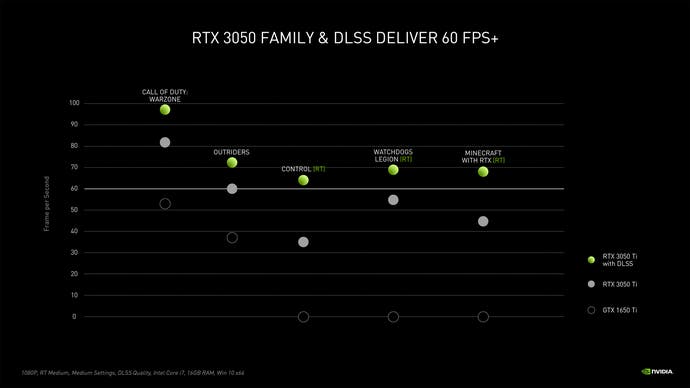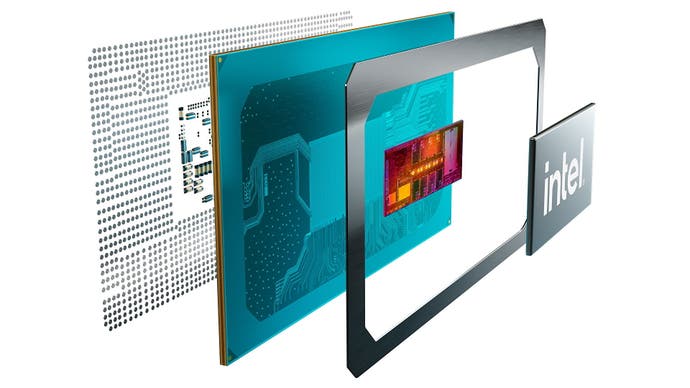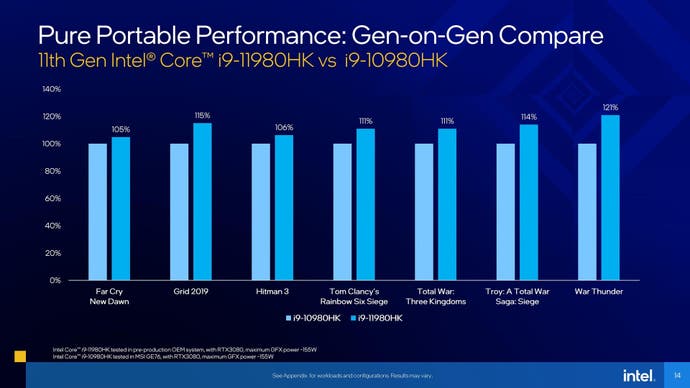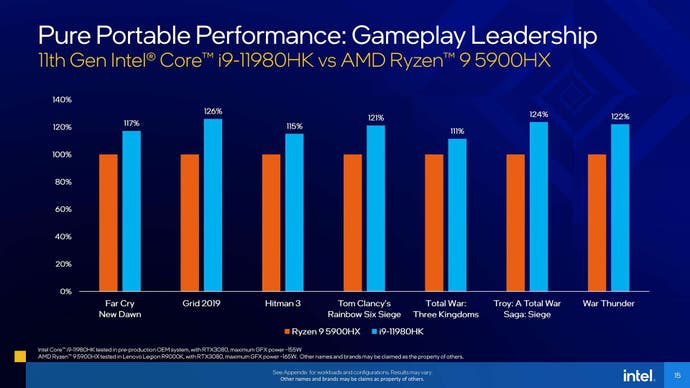Intel and Nvidia announce new 11th-gen laptop CPUs and RTX GPUs
Tiger Lake H! RTX 3050 and 3050 Ti! Read all about it!
Bad news: your gaming laptop is officially last-gen. That's the word from Intel and Nvidia, who teamed up today to announce new mobile processors and graphics cards. Intel is debuting their Tiger Lake H CPUs, bringing their 10nm process to high-performance 45W processors ideal for gaming or content creation, while Nvidia announced two new mobile graphics cards, the RTX 3050 and 3050 Ti. Here's what you need to know.
Let's cover Nvidia's announcements first, as the company is doing something a bit unusual here: they're announcing two new laptop GPUs with no desktop equivalents (yet). The RTX 3050 and 3050 Ti also bring the RTX featureset, eg ray tracing and DLSS, down to a much more mainstream segment of the market. Previously, you'd be lucky to find an RTX-equipped gaming laptop for much less than $1000, but now RTX machines will start at around $800 - and sales towards the end of the year, eg Black Friday, will no doubt bring that figure down even further. That's great news for game developers, as they can rely on gamers having access to RT even on mid-range machines when creating cross-platform games that are also targeting PS5 and Xbox Series X/S.

| GeForce Laptop | RTX 3080 | RTX 3070 | RTX 3060 | RTX 3050 Ti | RTX 3050 |
|---|---|---|---|---|---|
| GPU | GA104 | GA104 | GA106 | GA107(?) | GA107(?) |
| CUDA cores | 6144 | 5120 | 3840 | 2560 | 2048 |
| VRAM | 8/16GB GDDR6 | 6GB GDDR6 | 6GB GDDR6 | 4GB GDDR6 | 4GB GDDR6 |
| Memory Bus | 256-bit | 256-bit | 192-bit | 128-bit | 128-bit |
| Boost Clock | 1245-1710MHz | 1290-1620MHz | 1283-1703MHz | 1035-1695MHz | 1057-1740MHz |
| TDP | 80-150+W | 80-125W | 60-115W | 35-80W | 35-80W |
The 3050 and 3050 Ti are based on a new GPU from Nvidia, likely GA107, rather than being a cutdown version of the GA106 chip used in the RTX 3060. It uses the same 8nm Samsung process as its brothers and sisters, but ships with 2560 CUDA cores (in the fully-enabled RTX 3050 Ti, 2048 in the 3050), paired with 4GB of GDDR6 memory and a 128-bit memory bus - similar to the last-gen GTX 1650 and 1650 Ti.
In terms of performance, things will likely depend quite significantly on the TDP of the part, which can be adjusted by laptop makers anywhere from 35W to 80W. That in turn will influence the maximum boost clock, anywhere from 1035MHz on the low end to 1695MHz on the high-end. Those figures are for the 3050 Ti, and it's a similar story for the vanilla 3050, which can range between 1057MHz and 1740MHz. With the Max-P and Max-Q branding used by past generations put out to pasture, it will be important for potential buyers of these laptops to look at reviews from trusted sources or to at least scope out these power and frequency numbers to get a sense of the performance they can expect.

We don't have a full sense of actual performance right now, with Nvidia sharing just a few fps numbers for a handful of games at 1080p, medium settings with RT and DLSS enabled. The 3050 Ti should be capable of hitting 60 to 70fps in games like Control, Watchdogs Legion and Minecraft RTX, while Outriders and Call of Duty Warzone without RT are around 70 and 100fps, respectively. The theme for RTX 30-series laptop cards has generally been offering the same performance at a lower tier, so with any luck the 3050 Ti will resemble the RTX 2060 Super and the 3050 in turn the 2060, but we'll have to wait until these laptops hit the desks of reviewers before we see how representative Nvidia's numbers really are. It'll also be fascinating to see how the desktop equivalents of these cards perform too, assuming that they will be announced sooner or later!
Next up we have Intel. The launch of Nvidia's 30-series laptop GPUs earlier this year left the company in something of an awkward spot, as they didn't have a new 45W part ready to compete against AMD's Ryzen 5000 for laptops - so instead, the company had to continue offering its 10th-generation CPUs. These chips still performed fine, but it's only now that Team Blue has a proper counter to Ryzen 5000: Tiger Lake H.
These are the first high-performance 10nm SuperFin parts we've seen from Intel, which should bring with it a solid 19 percent IPC uplift over the previous generation. Combined with new techniques to keep sustained clock speeds higher, despite lower maximum boost clocks, the company is claiming that 11th-gen will be quite a significant upgrade for gaming in particular.
There are five models in the family, ranging from the fully unlocked and overclockable Core i9 11980HK to the mid-range Core i5 11260H. Between these, we have the usual Core i5/i7/i9 spread, with 6-core/12-thread designs for the Core i5 parts and 8-core/16-thread designs for the Core i7 and i9 models. (Previously, Core i5 was quad-core, which means the new 11th-gen Core i5 should benefit from some solid gen-on-gen improvements in modern games and content creation applications that can saturate as many threads as are available). 45W is the standard TDP for these chips, but again options will exist between 35W and 65W depending on the machine it's going into. The Core i9s are probably the most likely to be configured at that 65W "ultimate performance" level, and also have access to Turbo Boost Max 3.0, a technology that identifies and boosts the two best-performing cores - up to 5.0GHz for the 11980HK and 4.9GHz for the 11900H. The flagship part also gets access to Intel's Extreme Utility and Speed Optimiser apps, which should allow you to eke out even more performance, likely at the expense of noise and thermals.

| Model | Cores/ Threads | TDP | Max 2C Boost | Max All-Core Boost | L3 Cache |
|---|---|---|---|---|---|
| Core i9 11980HK | 8C/16T | 45W | 5.0GHz | 4.5GHz | 24MB |
| Core i9 11900H | 8C/16T | 45W | 4.9GHz | 4.4GHz | 24MB |
| Core i7 11800H | 8C/16T | 45W | 4.6GHz | 4.2GHz | 24MB |
| Core i5 11400H | 6C/12T | 45W | 4.5GHz | 4.1GHz | 12MB |
| Core i5 11260H | 6C/12T | 45W | 4.4GHz | 4.0GHz | 12MB |
As well as faster out-and-out CPU performance, Tiger Lake H also includes support for PCIe 4.0 (something missing from Ryzen 5000 on mobile), with 20 lanes available off the CPU (x16 for graphics and x4 for an SSD). Connectivity is also improved, with support for Thunderbolt 4 and WiFi 6/6E (the latter being WiFi 6 on the 6GHz spectrum). The graphics side of the equation has also been upgraded to use Intel's Xe architecture, although gaming laptops will likely use dedicated graphics like Nvidia's 30-series GPUs, above, and the graphics is still branded as 'UHD Graphics' with no mention of Xe.


So, what about actual performance numbers then? Again, these are thin on the ground and will need to be verified by independent testing, but they do look impressive. Slides provided by Intel show the 11980HK defeating the flagship Ryzen 9 5900HX by around 11 to 26 percent in a selection of games. In fact, Intel's claimed lead is so great that they show the 11400H, their second-slowest CPU, tying the second-best Ryzen 5900HS in a trio of games, then beating it in the other four by anywhere from three to 12 percent. In both cases, the two laptops compared weren't the same, but Intel made sure to bias the results in AMD's favour, with higher graphics TDPs for each of the systems tested. If those results are emblematic of gaming performance more generally, then 11th-gen could be quite a rebuttal to AMD's burgeoning laptop empire.

So there we have it - new CPUs, new GPUs and plenty of specs and features to test in the future. I hope you've found this write-up helpful, and we'll be sure to get in at least a few of the dozens and dozens of new laptops with these components for testing. Stay tuned!
An earlier version of this article referred to Intel's new Tiger Lake H laptop CPUs by the wrong codename. We regret the error.










